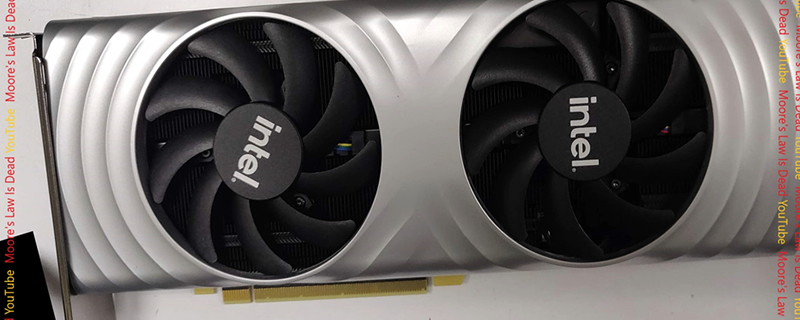Intel’s Arc Alchemist Graphics Cards Pictured – Xe-HPG Up Close
Intel’s Arc Alchemist Graphics Cards Pictured – Xe-HPG Up Close
Thanks to Moore’s Law is Dead, images of Intel’s early reference Arc Alchemist graphics cards have been made available online. This is pre-production hardware so expect Intel’s designs to change before we see them officially next year.Â
Below (and above), we have Intel’s DG2-512EU graphics card, which is presumably the company’s ARC Alchemist flagship graphics card model. This model features a dual-fan heatsink design and is powered using an 8-pin and a 6-pin PCIe power connector. This graphics card can consume a maximum of 225 watts of power between these two connectors, with up to 75 additional watts coming from the GPU’s PCIe connector. This makes Intel’s Xe-HPG flagship a sub-300W graphics card.  Â
Intel’s 512 EU Xe-HPG graphics card will reportedly feature 4096 FP32 shading units and 16GB of GDDR6 memory over a 256-bit memory bus. Recent rumours have suggested that this graphics card will compete with Nvidia’s Geforce RTX 3070 and AMD’s Radeon RX 6700 XT. That said, other reports have claimed that Intel is targeting higher-end GPU models from AMD and Nvidia.Â
 Â Â
 Â
Intel Arc Alchemist – DG2-128EU
Below, we have renders of Intel’s Arc Alchemist DG2-128EU graphics card, a model that should feature 1024 FP32 shading units and up to 8GB of GDDR6 memory on a 128-bit memory bus.Â
This graphics card will presumably have a 75-watt TDP, placing this graphics card within the low-end GPU market. Both Nvidia and AMD have failed to update this segment of the GPU market with their latest Ampere and RDNA 2 GPU architectures. This means that Intel will need to compete with last-generation RDNA 1 and Turing GPU offerings, which is great news for Intel.Â
Intel’s lower-end Arc series graphics cards will be best utilised within the mobile GPU market, acting as a powerful discrete graphics solution for compact gaming laptops. That said, this graphics card should also see a lot of use within desktop PC platforms, especially within the OEM PC market. Â
 Â Â
  
 Â
Intel’s due to launch their Arc Alchemist series GPUs in Q1 2022, with an official reveal being likely at CES 2022. This launch will add a third player to the discrete GPU market, adding more supply to today’s supply-constrained market while acting as a force that will compel AMD and Nvidia to work harder to maintain their current market share.Â
You can join the discussion on Intel’s Arc Alchemist graphics cards on the OC3D Forums.Â




